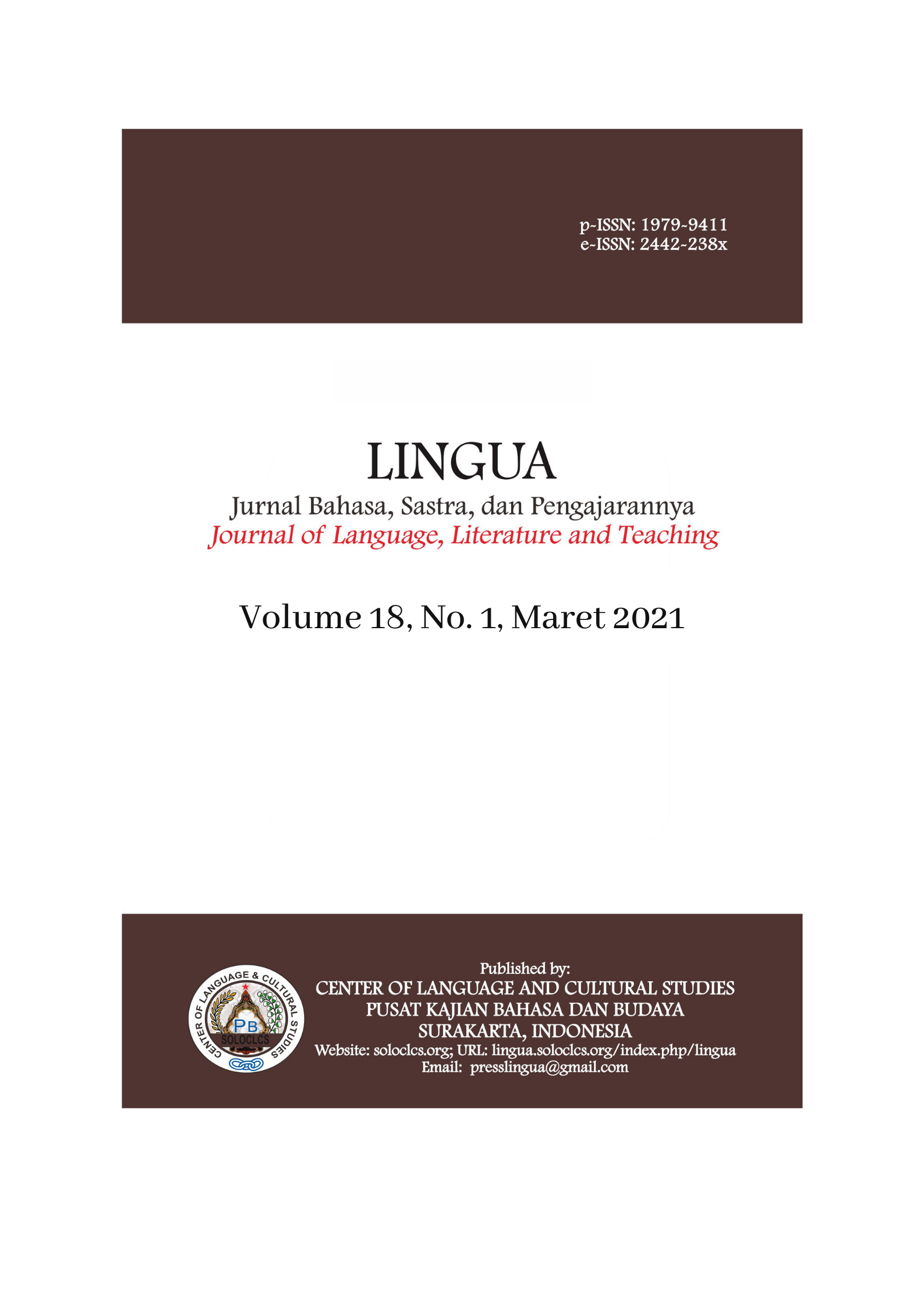Metafora dalam Pitaruah Ayah Karya Sanggar Balerong Jakarta
DOI:
https://doi.org/10.30957/lingua.v18i1.670Keywords:
metaphor, Pitaruah Ayah, meaning, functionAbstract
Pitaruah Ayah is one of the works of Sanggar Balerong Jakarta. Pitaruah Ayah is a message and advice that contains the teachings of life, both values ​​, and norms that apply in the life of Minangkabau people. The advice conveyed in the Pitaruah Ayah uses a lot of metaphorical languages where the most dominant one is a metaphor. Metaphor is a figurative language that compares one thing to another. This study aims to identify and describe the meaning and function of metaphors in Pitaruah Ayah. The method used in collecting data is the observation method with the advanced technique of uninvolved conversation observation. Furthermore, the identify method is used namely the referential and translational method. The results of the study show that the meaning of metaphor in Pitaruah Ayah is positive connotative and negative connotative. Of the two meanings, the most common meaning is positive connotative. Then, the metaphorical functions found in the work include directive and assertive functions.
Downloads
References
Arozi, Pahrudin dkk. (2020). “Leksikon Etnomedisin dalam Pengobatan Tradisional Sasak: Kajian Antropolinguistikâ€, Mabasan, 14(1). 17-29. mabasan.kemendikbud.go.id.
Apriliyanti, Afni devita dkk. (2020) “Metafora Konseptual dalam Lukas Graham 3
The Purple Album: Analisis Semantik Kognitifâ€, Semantik, 9(2), 85-92. e-
journal.stkipsiliwangi.ac.id.
Badudu, J.S. (1989). Inilah Bahasa Indonesia yang Benar III. Jakarta: PT. Gramedia.
Classe, Oliver. (2000). “Encyclopedia of Literary Translation into English†dalam jurnal: Fiztroy Dearborn Publishers (Volume 2).
Danial, Haris dkk. (2020). “Bentuk Lingual Metafora Bahasa Indonesia dalam Surat Kabarâ€, IDEAS, 6(3). 223-240. jurnal.ideaspublishing.ac.id.
Dedad, Muhammad Bisaraguna Akastangga. (2020). “Metafora dalam Tarjuman AL-ASHWAQ Karya Ibnu ‘Arabi Kajian Semantik Pragmatikâ€, JURNALISTRENDI, 5(1), 27-46. e-journal.unwmataram.ac.id.
Djafar, Cheche. (2020) “Kajian Diksi dan Gaya Bahasa Metafora Pada Puisi Ininawa Karya Lakon Sang Kelana Modies Palopoâ€, Pendidikan, 3(2), 1-7. ojs.unanda.ac.id.
Foley, W. (1997). Anthropological Lingusitics. An Introducion. China: Blackwell Publishing.
Fraser, B. (1979). The Interpretation of Novel Methapor. (Ortony: Ed.). Methapor and Thought. Cambridge: Cambridge University Press.
Frederick. K. Errington. (1984). Manners and meaning in West Sumatera: the social context of consciousness. New Haven and Landon: Yale University Press.
Keraf, Gorys. (1991). Diksi dan Gaya Bahasa. Jakarta: PT Gramedia Pustaka Utama.
Koentjaraninggrat. (2002). Pengantar Ilmu Antropologi. Jakarta: Rineka Cipta.
Kridalaksana, Harimurti. (2008). Kamus Linguistik. Jakarta: Gramedia Pustaka Utama.
Leech, Geoffrey. (1981). Semantics: The Study of Meaning. London: Penguin Group.
Leech, Geoffrey. (1993) Prinsip-Prinsip Pragmatik. Diterjemahkan oleh Dr. M Oka, MA dari judul asli: The Priciple of Pragmatics). Jakarta: Universitas Indonesia.
Leech, Geoffrey. (2003). Semantik (diterjemahkan oleh Paina Partana, dari judul asli: semantics). Yogyakarta: Pustaka Pelajar.
Mastoyo, Tri Kesuma Jati. (2007). Pengantar Metode Penelitian Bahasa. Yogyakarta. Penerbit Carasvatibooks.
Meko, Aron Mbete. (2004). Linguistik Kebudayaan: Rintisan Konsep dan Beberapa Aspek Kajiannya. Denpasar: Universitas Udayana.
Nahdi, Khirjan dkk. (2020). “Penciptaan Metafora dalam Ruang Presepsi Siswa Sekolah Dasarâ€, DIDIKA, 6(1). 14-23. e-journal.hamzanwadi.ac,id.
Sam’un, Ahmad. (2017). “Simbol dan Makna Budaya Nyawe? Dan Beras Pati: Upaya Pembertahanan Bahasa Masyarakat Sasakâ€, Lingua, 14(1). 78-88. www.soloclcs.org.
Sapta, Dairi Rindu Simanjuntak. (2020). “Penerapan Teori Linguistik Modern (Competence, Performance, Indexicality,& Partisipation) dalam Umpasa Batak Tobaâ€, Basis, 2(2). 71-78. e-journal.upbatam.ac.id.
Searle, J.R. (1979). EXPRESSION AND MEANING: Studies in the Theory of Speech Acts. Cambridge: Cambridge University Press.
Sibarani, Robert. (2004). Antropolinguistik. Medan: Pola.
Sjafnir, H. (2006). Siriah Pinang Adat Minangkabau Pengetahuan Adat Minangkabau Tematis. Padang: Sentra Budaya.
Sudaryanto. (1993). Metode dan Aneka Teknik Analisis Data. Yogyakarta. Duta Wacana University Press.
Sudaryanto. (2005). Metode dan Aneka Teknik Bahasa. Yogyakarta: Duta Wacana University Press.
Suryaningsih, Lily dkk. (2018). “Kajian Makna Nggahi Dana dan Makka Pada Budaya Penyambutan Tamu-tamu Besar di Dompuâ€, Lingua, 15(2). 83-96. www.soloclcs.org.
Wahab, Abdul. (1990). “Metafora Sebagai Alat Pelacak Sistem Ekologi†dalam PELLBA 3: Pertemuan Linguistik Lembaga Bahasa Atma jaya.
Wahab, Abdul. (1991). Isu Linguistik: Pengajaran Bahasa dan Sastra. Surabaya: Airlangga University Press.
Downloads
Published
How to Cite
Issue
Section
License
Authors who publish with this journal agree to the following terms:
- Authors retain copyright and grant the journal right of first publication with the work simultaneously licensed under a Creative Commons Attribution-ShareAlike 4.0 International License that allows others to share the work with an acknowledgement of the work's authorship and initial publication in this journal.
- Authors are able to enter into separate, additional contractual arrangements for the non-exclusive distribution of the journal's published version of the work (e.g., post it to an institutional repository or publish it in a book), with an acknowledgement of its initial publication in this journal.
- Authors are permitted and encouraged to post their work online (e.g., in institutional repositories or on their website) prior to and during the submission process, as it can lead to productive exchanges, as well as earlier and greater citation of published work (See The Effect of Open Access).















